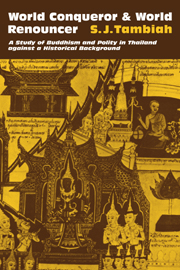 World Conqueror and World Renouncer
World Conqueror and World Renouncer Book contents
- Frontmatter
- Contents
- Acknowledgments
- PART ONE
- 1 Introduction: Reconstructing a Journey
- 2 From Rajadharma (the King's “Whole Duty”) to Dharmaraja (the “Righteous Ruler”)
- 3 The Brahmanical Theory of Society and Kingship
- 4 The Early Buddhist Conception of World Process, Dharma, and Kingship
- 5 Asoka Maurya: The Paradigm
- 6 Thai Kingship and Polity in Historical Perspective
- 7 The Galactic Polity
- 8 The Kingdom of Ayutthaya: Design and Process
- 9 Asokan and Sinhalese Traditions Concerning the Purification of the Sangha
- 10 The Sangha and the Polity: From Ayutthaya to Bangkok
- 11 The Nineteenth-Century Achievements of Religion and Sangha
- 12 The Sangha Acts of 1902, 1941, and 1963
- PART TWO
- Bibliography
- Index
4 - The Early Buddhist Conception of World Process, Dharma, and Kingship
Published online by Cambridge University Press: 10 November 2010
- Frontmatter
- Contents
- Acknowledgments
- PART ONE
- 1 Introduction: Reconstructing a Journey
- 2 From Rajadharma (the King's “Whole Duty”) to Dharmaraja (the “Righteous Ruler”)
- 3 The Brahmanical Theory of Society and Kingship
- 4 The Early Buddhist Conception of World Process, Dharma, and Kingship
- 5 Asoka Maurya: The Paradigm
- 6 Thai Kingship and Polity in Historical Perspective
- 7 The Galactic Polity
- 8 The Kingdom of Ayutthaya: Design and Process
- 9 Asokan and Sinhalese Traditions Concerning the Purification of the Sangha
- 10 The Sangha and the Polity: From Ayutthaya to Bangkok
- 11 The Nineteenth-Century Achievements of Religion and Sangha
- 12 The Sangha Acts of 1902, 1941, and 1963
- PART TWO
- Bibliography
- Index
Summary
Our analysis of the myth of genesis contained in the Agganna Suttanta showed that it had a balanced structure with the king on the one side mediating between social disorder and the formation of the four vannas (orders), of society itself, and with the bhikkhu on the other side, drawn from all four vannas, transcending society, mediating between home and homelessness and entering the path that leads from lokiya, this world, to lokottara, the other world of liberation. He (i.e., the bhikkhu) therefore is chief of them all, the king, the khattiya, the brahmanas, the vessa, and the sudda.
Early Buddhist literature contains instances of denunciation and devaluation of khattavijja, the kshatriya “science” of exercising coercive power. A Pali canonical text (Digha Nikaya 1, p. 9) declares that khattavijja belongs to a group of low arts (tirachchhanavijja) and wrongful occupations (michchhajiva) by which false ascetics and brahmans earn their livelihood. What is being railed against is not so much the ruling function per se but that kind of brahmanical – particularly arthashastric – formulation that went so far as to identify the kshatriya way of life with manipulative action inspired by self-preservation and self-interest. The Buddhist objections to certain arthashastric notions are, for example, portrayed in certain Jataka tales. In one story (No. 528) an ascetic denounces to the king the false doctrine of his ministers, a doctrine that condones the killing of parents, siblings, and friends if self-interest demands it.
- Type
- Chapter
- Information
- World Conqueror and World RenouncerA Study of Buddhism and Polity in Thailand against a Historical Background, pp. 32 - 53Publisher: Cambridge University PressPrint publication year: 1976
